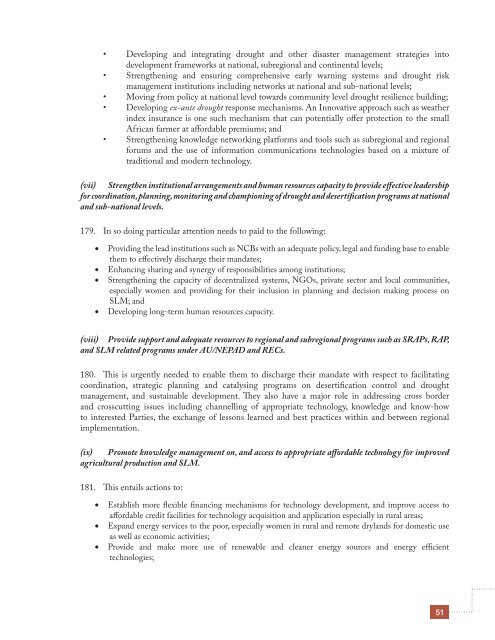drought desertification - United Nations Economic Commission for ...
drought desertification - United Nations Economic Commission for ...
drought desertification - United Nations Economic Commission for ...
You also want an ePaper? Increase the reach of your titles
YUMPU automatically turns print PDFs into web optimized ePapers that Google loves.
• Developing and integrating <strong>drought</strong> and other disaster management strategies into<br />
development frameworks at national, subregional and continental levels;<br />
• Strengthening and ensuring comprehensive early warning systems and <strong>drought</strong> risk<br />
management institutions including networks at national and sub-national levels;<br />
• Moving from policy at national level towards community level <strong>drought</strong> resilience building;<br />
• Developing ex-ante <strong>drought</strong> response mechanisms. An Innovative approach such as weather<br />
index insurance is one such mechanism that can potentially offer protection to the small<br />
African farmer at af<strong>for</strong>dable premiums; and<br />
• Strengthening knowledge networking plat<strong>for</strong>ms and tools such as subregional and regional<br />
<strong>for</strong>ums and the use of in<strong>for</strong>mation communications technologies based on a mixture of<br />
traditional and modern technology.<br />
(vii) Strengthen institutional arrangements and human resources capacity to provide effective leadership<br />
<strong>for</strong> coordination, planning, monitoring and championing of <strong>drought</strong> and <strong>desertification</strong> programs at national<br />
and sub-national levels.<br />
179.<br />
In so doing particular attention needs to paid to the following:<br />
• Providing the lead institutions such as NCBs with an adequate policy, legal and funding base to enable<br />
them to effectively discharge their mandates;<br />
• Enhancing sharing and synergy of responsibilities among institutions;<br />
• Strengthening the capacity of decentralized systems, NGOs, private sector and local communities,<br />
especially women and providing <strong>for</strong> their inclusion in planning and decision making process on<br />
SLM; and<br />
• Developing long-term human resources capacity.<br />
(viii) Provide support and adequate resources to regional and subregional programs such as SRAPs, RAP,<br />
and SLM related programs under AU/NEPAD and RECs.<br />
180. This is urgently needed to enable them to discharge their mandate with respect to facilitating<br />
coordination, strategic planning and catalysing programs on <strong>desertification</strong> control and <strong>drought</strong><br />
management, and sustainable development. They also have a major role in addressing cross border<br />
and crosscutting issues including channelling of appropriate technology, knowledge and know-how<br />
to interested Parties, the exchange of lessons learned and best practices within and between regional<br />
implementation.<br />
(ix) Promote knowledge management on, and access to appropriate af<strong>for</strong>dable technology <strong>for</strong> improved<br />
agricultural production and SLM.<br />
181.<br />
This entails actions to:<br />
• Establish more flexible financing mechanisms <strong>for</strong> technology development, and improve access to<br />
af<strong>for</strong>dable credit facilities <strong>for</strong> technology acquisition and application especially in rural areas;<br />
• Expand energy services to the poor, especially women in rural and remote drylands <strong>for</strong> domestic use<br />
as well as economic activities;<br />
• Provide and make more use of renewable and cleaner energy sources and energy efficient<br />
technologies;<br />
51

















